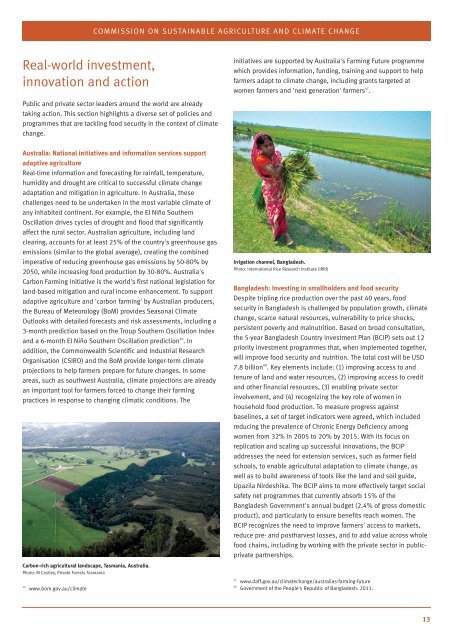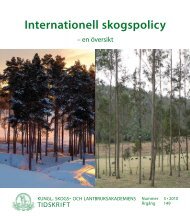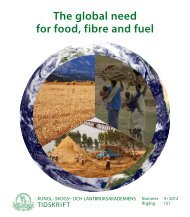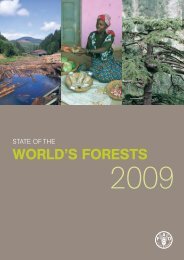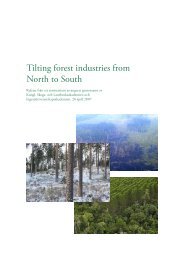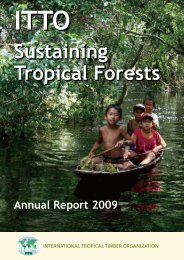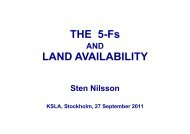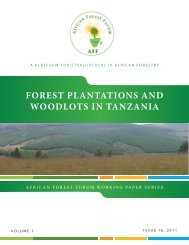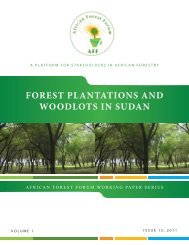Achieving food security in the face of climate change - CGSpace ...
Achieving food security in the face of climate change - CGSpace ...
Achieving food security in the face of climate change - CGSpace ...
You also want an ePaper? Increase the reach of your titles
YUMPU automatically turns print PDFs into web optimized ePapers that Google loves.
COMMISSION ON SUSTAINABLE AGRICULTURE AND CLIMATE CHANGE<br />
Real-world <strong>in</strong>vestment,<br />
<strong>in</strong>novation and action<br />
Public and private sector leaders around <strong>the</strong> world are already<br />
tak<strong>in</strong>g action. This section highlights a diverse set <strong>of</strong> policies and<br />
programmes that are tackl<strong>in</strong>g <strong>food</strong> <strong>security</strong> <strong>in</strong> <strong>the</strong> context <strong>of</strong> <strong>climate</strong><br />
<strong>change</strong>.<br />
<strong>in</strong>itiatives are supported by Australia's Farm<strong>in</strong>g Future programme<br />
which provides <strong>in</strong>formation, fund<strong>in</strong>g, tra<strong>in</strong><strong>in</strong>g and support to help<br />
farmers adapt to <strong>climate</strong> <strong>change</strong>, <strong>in</strong>clud<strong>in</strong>g grants targeted at<br />
women farmers and 'next generation' farmers 47 .<br />
Australia: National <strong>in</strong>itiatives and <strong>in</strong>formation services support<br />
adaptive agriculture<br />
Real-time <strong>in</strong>formation and forecast<strong>in</strong>g for ra<strong>in</strong>fall, temperature,<br />
humidity and drought are critical to successful <strong>climate</strong> <strong>change</strong><br />
adaptation and mitigation <strong>in</strong> agriculture. In Australia, <strong>the</strong>se<br />
challenges need to be undertaken <strong>in</strong> <strong>the</strong> most variable <strong>climate</strong> <strong>of</strong><br />
any <strong>in</strong>habited cont<strong>in</strong>ent. For example, <strong>the</strong> El Niño Sou<strong>the</strong>rn<br />
Oscillation drives cycles <strong>of</strong> drought and flood that significantly<br />
affect <strong>the</strong> rural sector. Australian agriculture, <strong>in</strong>clud<strong>in</strong>g land<br />
clear<strong>in</strong>g, accounts for at least 25% <strong>of</strong> <strong>the</strong> country's greenhouse gas<br />
emissions (similar to <strong>the</strong> global average), creat<strong>in</strong>g <strong>the</strong> comb<strong>in</strong>ed<br />
imperative <strong>of</strong> reduc<strong>in</strong>g greenhouse gas emissions by 50-80% by<br />
2050, while <strong>in</strong>creas<strong>in</strong>g <strong>food</strong> production by 30-80%. Australia's<br />
Carbon Farm<strong>in</strong>g Initiative is <strong>the</strong> world's first national legislation for<br />
land-based mitigation and rural <strong>in</strong>come enhancement. To support<br />
adaptive agriculture and 'carbon farm<strong>in</strong>g' by Australian producers,<br />
<strong>the</strong> Bureau <strong>of</strong> Meteorology (BoM) provides Seasonal Climate<br />
Outlooks with detailed forecasts and risk assessments, <strong>in</strong>clud<strong>in</strong>g a<br />
3-month prediction based on <strong>the</strong> Troup Sou<strong>the</strong>rn Oscillation Index<br />
and a 6-month El Niño Sou<strong>the</strong>rn Oscillation prediction 46 . In<br />
addition, <strong>the</strong> Commonwealth Scientific and Industrial Research<br />
Organisation (CSIRO) and <strong>the</strong> BoM provide longer-term <strong>climate</strong><br />
projections to help farmers prepare for future <strong>change</strong>s. In some<br />
areas, such as southwest Australia, <strong>climate</strong> projections are already<br />
an important tool for farmers forced to <strong>change</strong> <strong>the</strong>ir farm<strong>in</strong>g<br />
practices <strong>in</strong> response to chang<strong>in</strong>g climatic conditions. The<br />
Carbon-rich agricultural landscape, Tasmania, Australia.<br />
Photo: M Castley, Private Forests Tasmania<br />
46<br />
www.bom.gov.au/<strong>climate</strong><br />
Irrigation channel, Bangladesh.<br />
Photo: International Rice Research Institute (IRRI)<br />
Bangladesh: Invest<strong>in</strong>g <strong>in</strong> smallholders and <strong>food</strong> <strong>security</strong><br />
Despite tripl<strong>in</strong>g rice production over <strong>the</strong> past 40 years, <strong>food</strong><br />
<strong>security</strong> <strong>in</strong> Bangladesh is challenged by population growth, <strong>climate</strong><br />
<strong>change</strong>, scarce natural resources, vulnerability to price shocks,<br />
persistent poverty and malnutrition. Based on broad consultation,<br />
<strong>the</strong> 5-year Bangladesh Country Investment Plan (BCIP) sets out 12<br />
priority <strong>in</strong>vestment programmes that, when implemented toge<strong>the</strong>r,<br />
will improve <strong>food</strong> <strong>security</strong> and nutrition. The total cost will be USD<br />
7.8 billion 48 . Key elements <strong>in</strong>clude: (1) improv<strong>in</strong>g access to and<br />
tenure <strong>of</strong> land and water resources, (2) improv<strong>in</strong>g access to credit<br />
and o<strong>the</strong>r f<strong>in</strong>ancial resources, (3) enabl<strong>in</strong>g private sector<br />
<strong>in</strong>volvement, and (4) recogniz<strong>in</strong>g <strong>the</strong> key role <strong>of</strong> women <strong>in</strong><br />
household <strong>food</strong> production. To measure progress aga<strong>in</strong>st<br />
basel<strong>in</strong>es, a set <strong>of</strong> target <strong>in</strong>dicators were agreed, which <strong>in</strong>cluded<br />
reduc<strong>in</strong>g <strong>the</strong> prevalence <strong>of</strong> Chronic Energy Deficiency among<br />
women from 32% <strong>in</strong> 2005 to 20% by 2015. With its focus on<br />
replication and scal<strong>in</strong>g up successful <strong>in</strong>novations, <strong>the</strong> BCIP<br />
addresses <strong>the</strong> need for extension services, such as farmer field<br />
schools, to enable agricultural adaptation to <strong>climate</strong> <strong>change</strong>, as<br />
well as to build awareness <strong>of</strong> tools like <strong>the</strong> land and soil guide,<br />
Upazila Nirdeshika. The BCIP aims to more effectively target social<br />
safety net programmes that currently absorb 15% <strong>of</strong> <strong>the</strong><br />
Bangladesh Government's annual budget (2.4% <strong>of</strong> gross domestic<br />
product), and particularly to ensure benefits reach women. The<br />
BCIP recognizes <strong>the</strong> need to improve farmers' access to markets,<br />
reduce pre- and postharvest losses, and to add value across whole<br />
<strong>food</strong> cha<strong>in</strong>s, <strong>in</strong>clud<strong>in</strong>g by work<strong>in</strong>g with <strong>the</strong> private sector <strong>in</strong> publicprivate<br />
partnerships.<br />
47<br />
48<br />
www.daff.gov.au/<strong>climate</strong><strong>change</strong>/australias-farm<strong>in</strong>g-future<br />
Government <strong>of</strong> <strong>the</strong> People's Republic <strong>of</strong> Bangladesh. 2011.<br />
13


